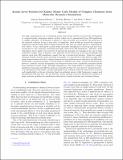Atomic-Level Features for Kinetic Monte Carlo Models of Complex Chemistry from Molecular Dynamics Simulations
Author(s)
Dufour-Décieux, Vincent; Freitas, Rodrigo; Reed, Evan J.
DownloadAccepted version (4.863Mb)
Open Access Policy
Open Access Policy
Creative Commons Attribution-Noncommercial-Share Alike
Terms of use
Metadata
Show full item recordAbstract
The high computational cost of evaluating atomic interactions recently motivated the development of computationally inexpensive kinetic models, which can be parameterized from molecular dynamics (MD) simulations of the complex chemistry of thousands of species or other processes and accelerate the prediction of the chemical evolution by up to four orders of magnitude. Such models go beyond the commonly employed potential energy surface fitting methods in that they are aimed purely at describing kinetic effects. So far, such kinetic models utilize molecular descriptions of reactions and have been constrained to only reproduce molecules previously observed in MD simulations. Therefore, these descriptions fail to predict the reactivity of unobserved molecules, for example, in the case of large molecules or solids. Here, we propose a new approach for the extraction of reaction mechanisms and reaction rates from MD simulations, namely, the use of atomic-level features. Using the complex chemical network of hydrocarbon pyrolysis as an example, it is demonstrated that kinetic models built using atomic features are able to explore chemical reaction pathways never observed in the MD simulations used to parameterize them, a critical feature to describe rare events. Atomic-level features are shown to construct reaction mechanisms and estimate reaction rates of unknown molecular species from elementary atomic events. Through comparisons of the model ability to extrapolate to longer simulation time scales and different chemical compositions than the ones used for parameterization, it is demonstrated that kinetic models employing atomic features retain the same level of accuracy and transferability as the use of features based on molecular species, while being more compact and parameterized with less data. We also find that atomic features can better describe the formation of large molecules enabling the simultaneous description of small molecules and condensed phases.
Date issued
2021-05Department
Massachusetts Institute of Technology. Department of Materials Science and EngineeringJournal
Journal of Physical Chemistry A
Publisher
American Chemical Society (ACS)
Citation
Dufour-Décieux, Vincent, Freitas, Rodrigo and Reed, Evan J. 2021. "Atomic-Level Features for Kinetic Monte Carlo Models of Complex Chemistry from Molecular Dynamics Simulations." Journal of Physical Chemistry A, 125 (19).
Version: Author's final manuscript
ISSN
1089-5639
1520-5215